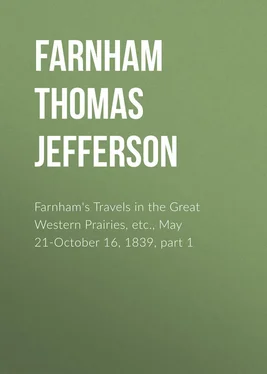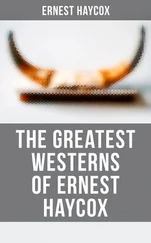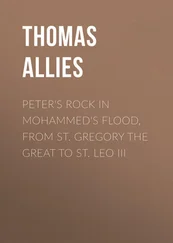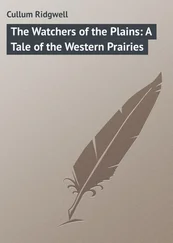Thomas Farnham - Farnham's Travels in the Great Western Prairies, etc., May 21-October 16, 1839, part 1
Здесь есть возможность читать онлайн «Thomas Farnham - Farnham's Travels in the Great Western Prairies, etc., May 21-October 16, 1839, part 1» — ознакомительный отрывок электронной книги совершенно бесплатно, а после прочтения отрывка купить полную версию. В некоторых случаях можно слушать аудио, скачать через торрент в формате fb2 и присутствует краткое содержание. Издательство: Иностранный паблик, Жанр: foreign_antique, foreign_prose, Путешествия и география, на английском языке. Описание произведения, (предисловие) а так же отзывы посетителей доступны на портале библиотеки ЛибКат.
- Название:Farnham's Travels in the Great Western Prairies, etc., May 21-October 16, 1839, part 1
- Автор:
- Издательство:Иностранный паблик
- Жанр:
- Год:неизвестен
- ISBN:нет данных
- Рейтинг книги:3 / 5. Голосов: 1
-
Избранное:Добавить в избранное
- Отзывы:
-
Ваша оценка:
- 60
- 1
- 2
- 3
- 4
- 5
Farnham's Travels in the Great Western Prairies, etc., May 21-October 16, 1839, part 1: краткое содержание, описание и аннотация
Предлагаем к чтению аннотацию, описание, краткое содержание или предисловие (зависит от того, что написал сам автор книги «Farnham's Travels in the Great Western Prairies, etc., May 21-October 16, 1839, part 1»). Если вы не нашли необходимую информацию о книге — напишите в комментариях, мы постараемся отыскать её.
Farnham's Travels in the Great Western Prairies, etc., May 21-October 16, 1839, part 1 — читать онлайн ознакомительный отрывок
Ниже представлен текст книги, разбитый по страницам. Система сохранения места последней прочитанной страницы, позволяет с удобством читать онлайн бесплатно книгу «Farnham's Travels in the Great Western Prairies, etc., May 21-October 16, 1839, part 1», без необходимости каждый раз заново искать на чём Вы остановились. Поставьте закладку, и сможете в любой момент перейти на страницу, на которой закончили чтение.
Интервал:
Закладка:
The Santa Féäns, when on march through these plains, are in constant expectation of these tornadoes. Accordingly, when the sky at night indicates their approach, they chain the wheels of adjacent waggons strongly together to prevent them from being upset – an accident that has often happened, when this precaution was not taken. It may well be conceived, too, that to prevent their goods from being wet in such cases, requires a covering of no ordinary powers of protection. Bows in the usual form, except that they are higher, are raised over long sunken Pennsylvania waggons, over which are spread two or three thicknesses of woollen blankets; and over these, and extended to the lower edge of the body, is drawn a strong canvas covering, well guarded with cords and leather straps. Through this covering these tempests seldom penetrate.
At seven o'clock on the morning of the 27th, "Catch up, catch up," rang round the waggons of the Santa Féäns. Immediately each man had his hand upon a horse or mule; and ere we, in attempting to follow their example, had our horses by the halter, the teams were harnessed and ready for the "march." A noble sight those teams were, about forty in number, their immense waggons still unmoved, forming an oval breastwork of wealth, girded by an impatient mass of near four hundred mules, harnessed and ready to move again along their solitary way. But the interest of the scene was much increased when, at the call of the commander, the two lines, team after team, straightened themselves into the trail, and rode majestically away over the undulating plain. We crossed the Pawnee Fork, 44 44 For Pawnee Fork see our volume xvi, p. 227, note 105. – Ed.
and visited the Caw Camp. Their wigwams were constructed of bushes inserted into the ground, twisted together at the top, and covered with the buffalo hides which they had been gathering for their winter lodges. Meat was drying in every direction. It had been cut in long narrow strips, wound around sticks standing upright in the ground, or laid over a rick of wicker-work, under which slow fires are kept burning. The stench, and the squalid appearance of the women and children, were not sufficiently interesting to detain us long; and we travelled on for the buffalo which were bellowing over the hills in advance of us. There appeared to be about one thousand five hundred souls, almost in a state of nudity, and filthy as swine. They make a yearly hunt to this region in the spring, lay in a large quantity of dried meat, return to their own territory in harvest time, gather their beans and corn, make the buffalo hides, (taken before the hair is long enough for robes), into conical tents, and thus prepare for a long and merry winter.
They take with them, on these hunting excursions, all the horses and mules belonging to the tribe, which can be spared from the labour of their fields upon the Konzas River, go south till they meet the buffalo, build their distant wigwams, and commence their labour. This is divided in the following manner between the males, females, and children: – The men kill the game. The women dress and dry the meat, and tan the hides. The instruments used in killing vary with the rank and wealth of each individual. The high chief has a lance, with a handle six feet and blade three feet in length. This in hand, mounted upon a fleet horse, he rides boldly to the side of the flying buffalo, and thrusts it again and again through the liver or heart of one, and then another of the affrighted herd till his horse is no longer able to keep near them. He is thus able to kill five or six, more or less, at a single hit. Some of the inferior chiefs also have these lances; but they must all be shorter than that of his Royal Darkness. The common Indians use muskets and pistols. Rifles are an abomination to them. The twisting motion of the ball as it enters, the sharp crack when discharged, and the direful singing of the lead as it cuts the air, are considered symptoms of witchcraft that are unsafe for the Red Man to meddle with. They call them medicines – inscrutable and irresistible sources of evil. The poorer classes still use the bow and arrow. Nor is this, in the well-trained hand of the Indian, a less effective weapon than those already mentioned. Astride a good horse, beside a bellowing band of wild beef, leaning forward upon the neck, and drawing his limbs close to the sides of his horse, the naked hunter uses his national weapon with astonishing dexterity and success. Not unfrequently, when hitting no bones, does he throw his arrows quite through the buffalo. Twenty or thirty thus variously armed, advance upon a herd. The chief leads the chase, and by the time they come alongside the band, the different speed of the horses has brought them into a single file or line. Thus they run until every individual has a buffalo at his side. Then the whole line fire guns, throw arrows or drive lances, as often and as long as the speed of the horses will allow; and seldom do they fail in encounters of this kind, to lay upon the dusty plain numbers of these noble animals.
A cloud of squaws who had been hovering in the neighbourhood, now hurry up, astride of pack-animals, strip off hides, cut off the best flesh, load their pack saddles, mount themselves on the top, and move slowly away to the camp. The lords of creation have finished their day's labour. The ladies cure the meat in the manner described above, stretch the hides upon the ground, and with a blunt wooden adze hew them into leather. The younger shoots of the tribe during the day are engaged in watering and guarding the horses and mules that have been used in the hunt – changing their stakes from one spot to another of fresh grass, and crouching along the heights around the camp to notice the approach of foes, and sound the alarm. Thus the Konzas, Kausaus, or Caws, lay in their annual stores. Unless driven from their game by the Pawnees, or some other tribe at enmity with them, they load every animal with meat and hides about the first of August, and commence the march back to their fields, fathers, and wigwams, on the Konzas River.
This return-march must present a most interesting scene in savage life – seven hundred or eight hundred horses or mules loaded with the spoils of the chase, and the children of the tribe holding on to the pack with might and main, naked as eels, and shining with buffalo grease, their fathers and mothers loafing on foot behind, with their guns poised on the left arm, or their bows and arrows swung at their back ready for action, and turning their heads rapidly and anxiously for lurking enemies – the attack, the screams of women and children, each man seizing an animal for a breastwork, and surrounding thus their wives and children, the firing, the dying, the conquest, the whoop of victory and rejoicings of one party, and the dogged, sullen submission of the other – all this and more has occurred a thousand times upon these plains, and is still occurring. But if victory declare for the Caws, or they march to their home without molestation, how many warm affections spring up in their untamed bosoms, as they see again their parents and children, and the ripened harvest, the woods, the streams, and bubbling springs, among which the gleeful days of childhood were spent! And when greetings are over, and welcomes are said, embraces exchanged, and their homes seen and smiled upon; in fine, when all the holy feelings of remembrance, and their present good fortune, find vent in the wild night-dance, who, that wears a white skin and ponders upon the better lot of civilized men, will not believe that the Indian too, returned from the hunt and from war, has not as much happiness, if not in kind the same, and as many sentiments that do honour to our nature, as are wrapped in the stays and tights of a fantastic, mawkish civilization – that flattering, pluming, gormandizing, unthinking, gilded life, which is beginning to measure mental and moral worth by the amount of wealth possessed, and the adornment of a slip or pew in church.
Читать дальшеИнтервал:
Закладка:
Похожие книги на «Farnham's Travels in the Great Western Prairies, etc., May 21-October 16, 1839, part 1»
Представляем Вашему вниманию похожие книги на «Farnham's Travels in the Great Western Prairies, etc., May 21-October 16, 1839, part 1» списком для выбора. Мы отобрали схожую по названию и смыслу литературу в надежде предоставить читателям больше вариантов отыскать новые, интересные, ещё непрочитанные произведения.
Обсуждение, отзывы о книге «Farnham's Travels in the Great Western Prairies, etc., May 21-October 16, 1839, part 1» и просто собственные мнения читателей. Оставьте ваши комментарии, напишите, что Вы думаете о произведении, его смысле или главных героях. Укажите что конкретно понравилось, а что нет, и почему Вы так считаете.












